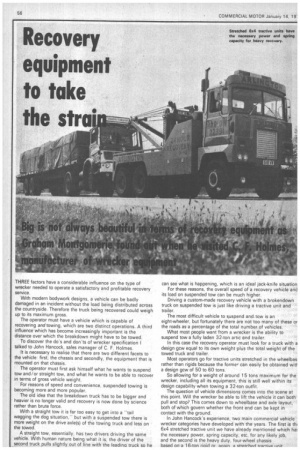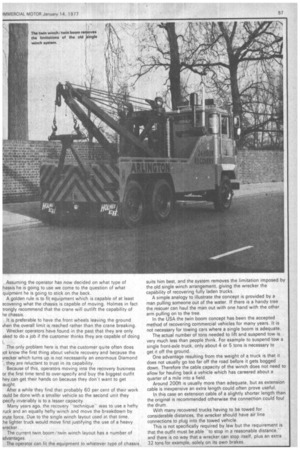Recovery equipment to take the stra
Page 58

Page 59

If you've noticed an error in this article please click here to report it so we can fix it.
THREE factors have a considerable influence on the type of wrecker needed to operate a satisfactory and profitable recovery service.
With modern bodywork designs, a vehicle can be badly damaged in an incident without the load being distributed across the countryside_ Therefore the truck being recovered could weigh up to its maximum gross.
The operator must have a vehicle which is capable of recovering and towing, which are two distinct operations. A third influence which has become increasingly important is the distance over which the breakdown might have to be towed.
To discover the do's and don'ts of wrecker specification I talked to John Hancock, sales manager of C. F. Holmes.
It is necessary to realise that there are two different facets to the vehicle • first, the chassis and secondly, the equipment that is mounted on that chassis.
The operator must first ask himself what he wants to suspend tow and/or straight tow, and what he wants to be able to recover in terms of gross vehicle weight.
For reasons of speed and convenience, suspended towing is becoming more and more popular.
The old idea that the breakdown truck has to be bigger and heavier is no longer valid and recovery is now done by science rather than brute force.
With a straight tow it is far too easy to get into a "'tail wagging the dog situation,but with a suspended tow there is more weight on the drive axle(s) of the towing truck and less on the towed.
A straight tow, essentially, has two drivers driving the same vehicle. With human nature being what it is. the driver of the second truck pulls slightly out of line with the leadina truck so he can see what is happening, which is an ideal jack-knife situation For these reasons, the overall speed of a recovery vehicle and its load on suspended tow can be much higher.
Driving a custom-made recovery vehicle with a brokendown truck on suspended tow is just like driving a tractive unit and trailer.
The most difficult vehicle to suspend and.tow is an eight-wheeler, but fortunately there are not too many of these or the roads as a percentage of the total number of vehicles.
What most people want from a wrecker is the ability to suspend tow a fully laden 32-ton artic and trailer.
In this case the recovery operator must look for a truck with a design gcw equal to its own weight plus the total weight of the towed truck and trailer.
Most operators go for tractive units stretched in the wheelbas rather than rigids because the former can easily be obtained will a design gcw of 50 to 60 tons.
So allowing for a weight of around 15 tons maximum for the wrecker, including all its equipment, this is still well within its design capability when towing a 32-ton outfit.
The question of vehicle dimensions comes into the scene at this point. Will the wrecker be able to lift the vehicle it can both pull and stop? This comes down to wheelbase and axle layout both of which govern whether the front end can be kept in contact with the ground.
In John Hancock's experience, two main commercial vehicle wrecker categories have developed with the years. The first is ail 6x4 stretched tractive unit we have already mentioned which ha: the necessary power, spring capacity, etc, for any likely job, and the second is the heavy duty, four-wheel chassis
based on a 16-ton riaid rir anain a stretrheri trartivP [mit
Assuming the operator has now decided on what type of hassis he is going to use we come to the question of what quipment he is going to stick on the back.
A golden rule is to fit equipment which is capable of at least ecovering what the chassis is capable of moving. Holmes in fact trongly recommend that the crane will outlift the capability of he chassis.
It is preferable to have the front wheels leaving the ground vhen the overall limit is reached rather than the crane breaking. Wrecker operators have found in the past that they are only isked to do a job if the customer thinks they are capable of doing The only problem here is that the customer quite often does lot know the first thing about vehicle recovery and because the vrecker which turns up is not necessarily an enormous Diamond -, they are reluctant to trust in its capability.
Because of this, operators moving into the recovery business or the first time tend to over-specify and buy the biggest outfit hey can get their hands on because they don't want to get aught After a while they find that probably 60 per cent of their work :ould be done with a smaller vehicle so the second unit they pecify invariably is to a lesser capacity.
Many years ago, the recovery "techniquewas to use a hefty ruck and an equally hefty winch and move the breakdown by )rute force. Due to the single winch layout used at that time, he lighter truck would move first justifying the use of a heavy rvrecker. .
The current twin boom/twin winch layout has a number of 3dvantages.
The operator can fit the equipment to whatever type of chassis suits him best, and the system removes the limitation imposed by the old single winch arrangement, giving the wrecker the capability of recovering fully laden trucks.
A simple analogy to illustrate the concept is provided by a man pulling someone out of the water. If there is a handy tree the rescuer can haul the man out with one hand with the other arm pulling on to the tree.
In the USA the twin boom concept has been the accepted method of recovering commercial vehicles for many years. It is not necessary for towing cars where a single boom is adequate.
The actual number of tons needed to lift and suspend tow is very much less than people think. For example to suspend tow a single front-axle truck, only about 4 or 5 tons is necessary to get it off the ground.
One advantage resulting from the weight of a truck is that it does not usually go too far off the road before it gets bogged down. Therefore the cable capacity of the winch does not need to allow for hauling bock a vehicle which has careered about a quarter of a mile into a field. Around 200ft is usually more than adequate, but as extension cable is inexpensive an extra length could often prove useful.
In this case an extension cable of a slightly shorter length than the original is recommended otherwise the connection could foul the drum.
With many recovered trucks having to be towed for considerable distances, the wrecker should have air line connections to plug into the towed vehicle.
This is not specifically required by law but the requirement is that the outfit must be able -to stop in a reasonable distance," and there is no way that a wrecker can stop itself, plus an extra 32 tons for example, solely on its own brakes.








































































































